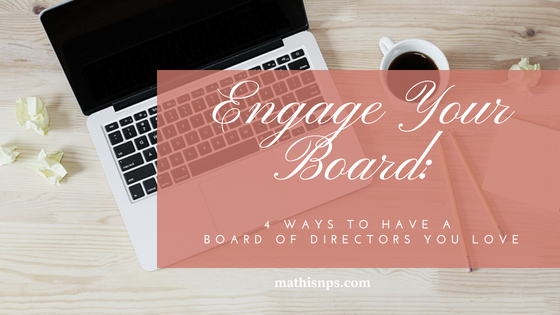Your nonprofit Board of Directors are important leaders of your organization and their primary responsibilities are 1. Advocacy (individually and collectively), 2. Policy (setting policy), 3. Fundraising (actively involved in the Fundraising process). These three can often be summed up as time, talent, and treasure. If you are a new organization, they may have to roll up their sleeves and get tasks done that keep programs going. But how do you get them engaged? How do you get them excited to roll up their sleeves? In my experience on Boards and in researching this topic, I have come to the conclusion that there are four reasons for a lack of engagement. They are:
- Misalignment of Mission
- Passively Managed Expectations
- Communication Silos
- Unplugged Talent
Aligning the Board with Organization’s Mission
The first, misalignment of the mission, can be managed from the recruitment process. If you share your passion, mission, and vision at that first meeting, you have already laid the groundwork. To keep your Board aligned with your mission, make sure you are incorporating time in every meeting to talk about the mission and how its being accomplished. Talk about the good you are doing and how you are aligning with your strategic plan. Show the forward progress you are making. Also, make time at each Board meeting to allow Board members to report on how they advocated for your organization. Making your mission and vision front and center at every Board meeting keeps all Board members aligned with the organization’s mission and will allow you to see if a Board member is straying from the mission. You may need to have a private conversation with the Board member if that’s the case.
Proactively Setting Expectations and Reminding Board of Expectations
Passively managed expectations can be the single biggest contributor to lack of engagement.
You have to make sure expectations are clear and remind your nonprofit Board often. Board report cards are one way you can do this. Two report cards are given to each Board member. One report card is filled out by the Board member on themselves. The other is filled out on the Board collectively. The Chairman of the Board/Chairman will privately discuss the individual report card with the Board member. The collective Board report card will be discussed with the entire Board. This is not a time to call out individuals but to assess the effectiveness of the Board as a whole. Use this time to see your strengths and acknowledge your weaknesses. Can you improve those weaknesses? Do you need to find Board members with those strengths?
A commitment grid can be another method to call attention to a Board member’s strengths and weaknesses or just simply make them aware of the expectations they aren’t meeting. To create this grid, put your expectations down the left-hand side. Put the numbers 1-5 across the top. Use 1- Not meeting expectations, 2- meets expectations occasionally, 3- meets expectations consistently, 4- meets expectations and sometimes goes above and beyond, 5- meets and exceeds expectations on a consistent basis.
Make sure you are providing Board Training to address any issues the Board may need more knowledge or information on.
Helping your Board be more effective will allow them to be more engaged. Share your ideas of what Board engagement looks like. What would your Board be able to do if ..? If they gave? If they shared their talents and skills? If they introduced you to …? Sometimes a little vision casting can be more inspiring than a morale beating.
Last, as hard as it may be to do, you have to take action when a Board member isn’t meeting expectations.
Maybe it’s just sitting down one on one and expressing your concern that they aren’t meeting expectations. Be human about it. Maybe there is a family illness you didn’t know about. Offer to help them meet expectations. Don’t do it for them but figure out a game plan to help them take the steps to be an engaged member. Sometimes it is an experience of sitting on a Board that may be the obstacle. This is definitely something you can help with. Maybe you assign a “buddy” to mentor the member. If that doesn’t work, you have to make the hard decision to cut the member loose. You can’t have dead weight and still get the things done that need to be done to move your mission forward.
Communication Silos
Communication silos happen when only a certain few are “in the loop” and others are excluded.
They will quickly make an organization ineffective. Communication silos in Boards create the culture that communication silos are okay. The problem is that when people begin operating in a vacuum, people will make stuff up. Here are some ideas to keep the communication silos from happening.
Communicate meetings. Give meeting materials in plenty of time for the member to be prepared. Allow time in meetings for real discussions. It’s easy to fall into “the rubber stamp” method. But to be a strong organization, you need to listen to all opinions- not shut them down by dismissing them before really mulling them over.
Be transparent.
Give as many details as you know when talking to Board members. Hold meetings and make decisions with the whole Board. Committees and “Teams” can make recommendations but they can’t make policy without the full Board’s consent.
Thank Your Board members.
It may seem simple but it can mean the world to some who value appreciation.
Check in with Board members or create a Board Liaison to check in between meetings.
Your Board should be working to complete tasks between meetings. Have someone check on them with the intention of finding out:
- How their assigned tasks are going.
- Do they have important dates on their calendar?
- How can you help? Where are they getting stuck?
- Create a password protected area of your website or a private Facebook Group to communicate with members.
- Listen and Act. Listen to your Board members and act on their suggestions, if you can. Above all, make them feel heard.
Unplugged Talent
Make sure you know the skills of your Board of Directors and those skills they are willing to use for your organization. Knowing the skills they want to use, will help you plug members into areas they will thrive, be excited, and engage. Have a brief bio in your onboarding process for all Board members. This will help everyone know who to ask for what.
Value your Board of Directors’ expertise and skills. Seeking their counsel inside and outside of Board meetings and truly mulling it over will go along way. Make sure everyone is assigned tasks in their strengths or just a stretch of their talents. Sometimes being stretched can be challenging and rewarding. Last, make sure tasks are being assigned evenly among the group. A good way to burn your Board members out is continuously assigning tasks to one (or a few) and can signal that you don’t value others on the team that can do the job instead.
Conclusion
There you have it. To give your organization a fighting chance, you must concentrate on four key areas of engagement. Mission Alignment, Clear and Repeated Expectations, Communication, and Using the Skills of the Board. Now, it’s time to get to work.


 Most nonprofit leaders lay awake at night trying to figure out how to fund their mission.
Hi! I'm Alesha.
I teach sustainable fundraising in a way that they can take action today so they can serve their clients.
I can help you move from just getting started funding your new nonprofit to gaining confidence in your fundraising and building relationships to knowing what works for your organization and looking at the infinite game when it comes to funding. I’ve worked with nonprofit Founders and written the book I HAVE MY 501(C)3! NOW WHAT?!? Your Blueprint to Starting Your Nonprofit Without Being the Sole Funder that lays the foundations for funding in a new nonprofit.
I’ve worked in Development (Fundraising) Departments in large organizations and I know the no cost, low-cost methods they use to bring in funding. I bring those sound strategies to the nonprofits I serve.
Most nonprofit leaders lay awake at night trying to figure out how to fund their mission.
Hi! I'm Alesha.
I teach sustainable fundraising in a way that they can take action today so they can serve their clients.
I can help you move from just getting started funding your new nonprofit to gaining confidence in your fundraising and building relationships to knowing what works for your organization and looking at the infinite game when it comes to funding. I’ve worked with nonprofit Founders and written the book I HAVE MY 501(C)3! NOW WHAT?!? Your Blueprint to Starting Your Nonprofit Without Being the Sole Funder that lays the foundations for funding in a new nonprofit.
I’ve worked in Development (Fundraising) Departments in large organizations and I know the no cost, low-cost methods they use to bring in funding. I bring those sound strategies to the nonprofits I serve.